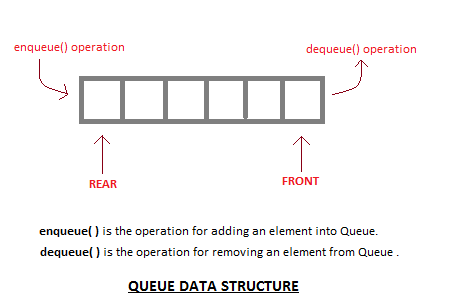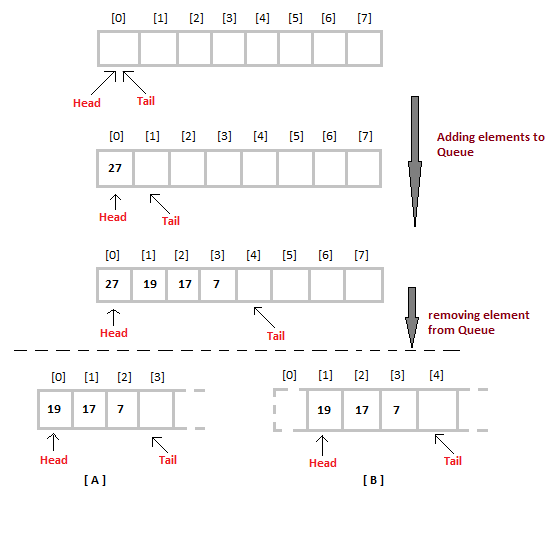What is a Queue Data Structure?
What is a Queue Data Structure?
Queue is also an abstract data type or a linear data structure, just like stack data structure, in which the first element is inserted from one end called the REAR(also called tail), and the removal of existing element takes place from the other end called as FRONT(also called head).
This makes queue as FIFO(First in First Out) data structure, which means that element inserted first will be removed first.
Which is exactly how queue system works in real world. If you go to a ticket counter to buy movie tickets, and are first in the queue, then you will be the first one to get the tickets. Right? Same is the case with Queue data structure. Data inserted first, will leave the queue first.
The process to add an element into queue is called Enqueue and the process of removal of an element from queue is called Dequeue.

Basic features of Queue
- Like stack, queue is also an ordered list of elements of similar data types.
- Queue is a FIFO( First in First Out ) structure.
- Once a new element is inserted into the Queue, all the elements inserted before the new element in the queue must be removed, to remove the new element.
peek( )function is oftenly used to return the value of first element without dequeuing it.
Applications of Queue
Queue, as the name suggests is used whenever we need to manage any group of objects in an order in which the first one coming in, also gets out first while the others wait for their turn, like in the following scenarios:
- Serving requests on a single shared resource, like a printer, CPU task scheduling etc.
- In real life scenario, Call Center phone systems uses Queues to hold people calling them in an order, until a service representative is free.
- Handling of interrupts in real-time systems. The interrupts are handled in the same order as they arrive i.e First come first served.
Implementation of Queue Data Structure
Queue can be implemented using an Array, Stack or Linked List. The easiest way of implementing a queue is by using an Array.
Initially the head(FRONT) and the tail(REAR) of the queue points at the first index of the array (starting the index of array from
0). As we add elements to the queue, the tail keeps on moving ahead, always pointing to the position where the next element will be inserted, while the head remains at the first index.
When we remove an element from Queue, we can follow two possible approaches (mentioned [A] and [B] in above diagram). In [A] approach, we remove the element at head position, and then one by one shift all the other elements in forward position.
In approach [B] we remove the element from head position and then move head to the next position.
In approach [A] there is an overhead of shifting the elements one position forward every time we remove the first element.
In approach [B] there is no such overhead, but whenever we move head one position ahead, after removal of first element, the size on Queue is reduced by one space each time.
Algorithm for ENQUEUE operation
- Check if the queue is full or not.
- If the queue is full, then print overflow error and exit the program.
- If the queue is not full, then increment the tail and add the element.
Algorithm for DEQUEUE operation
- Check if the queue is empty or not.
- If the queue is empty, then print underflow error and exit the program.
- If the queue is not empty, then print the element at the head and increment the head.
/* Below program is written in C++ language */
#include<iostream>
using namespace std;
#define SIZE 10
class Queue
{
int a[SIZE];
int rear; //same as tail
int front; //same as head
public:
Queue()
{
rear = front = -1;
}
//declaring enqueue, dequeue and display functions
void enqueue(int x);
int dequeue();
void display();
};
// function enqueue - to add data to queue
void Queue :: enqueue(int x)
{
if(front == -1) {
front++;
}
if( rear == SIZE-1)
{
cout << "Queue is full";
}
else
{
a[++rear] = x;
}
}
// function dequeue - to remove data from queue
int Queue :: dequeue()
{
return a[++front]; // following approach [B], explained above
}
// function to display the queue elements
void Queue :: display()
{
int i;
for( i = front; i <= rear; i++)
{
cout << a[i] << endl;
}
}
// the main function
int main()
{
Queue q;
q.enqueue(10);
q.enqueue(100);
q.enqueue(1000);
q.enqueue(1001);
q.enqueue(1002);
q.dequeue();
q.enqueue(1003);
q.dequeue();
q.dequeue();
q.enqueue(1004);
q.display();
return 0;
}
To implement approach [A], you simply need to change the
dequeue method, and include a for loop which will shift all the remaining elements by one position.
return a[0]; //returning first element
for (i = 0; i < tail-1; i++) //shifting all other elements
{
a[i] = a[i+1];
tail--;
}Complexity Analysis of Queue Operations
Just like Stack, in case of a Queue too, we know exactly, on which position new element will be added and from where an element will be removed, hence both these operations requires a single step.
- Enqueue: O(1)
- Dequeue: O(1)
- Size: O(1)
Comments
Post a Comment
Thanks for comment. We will get back to you soon...